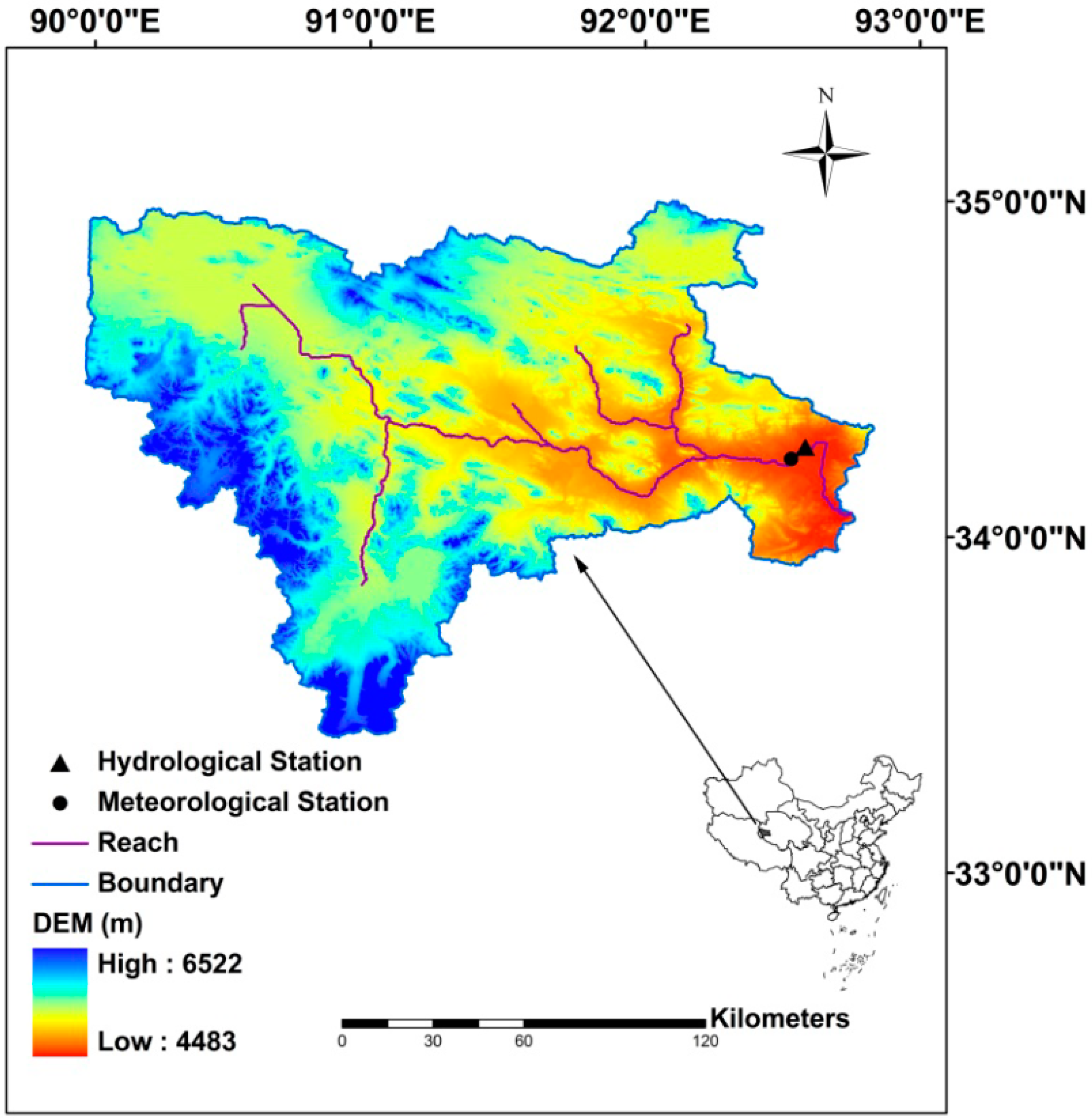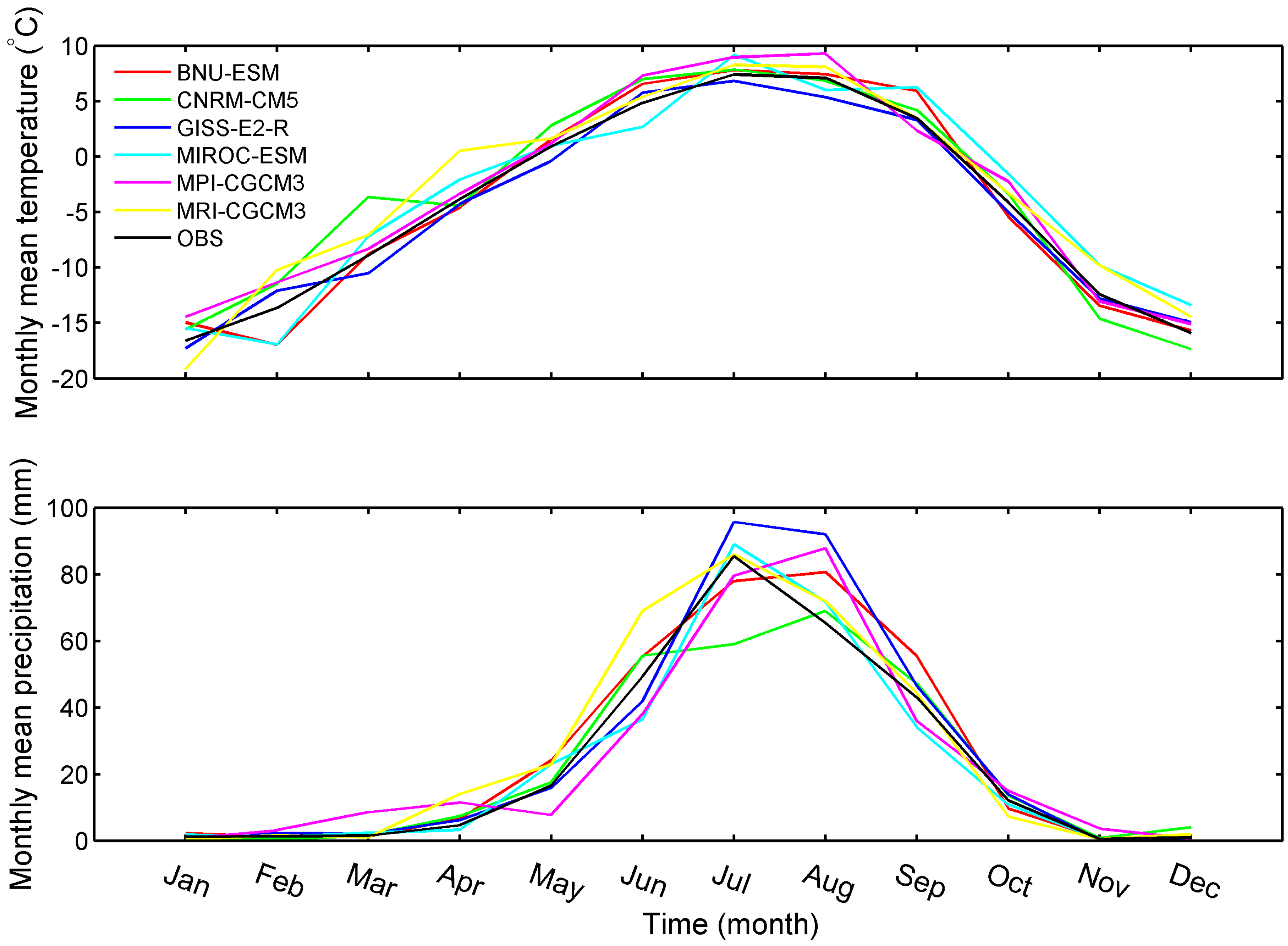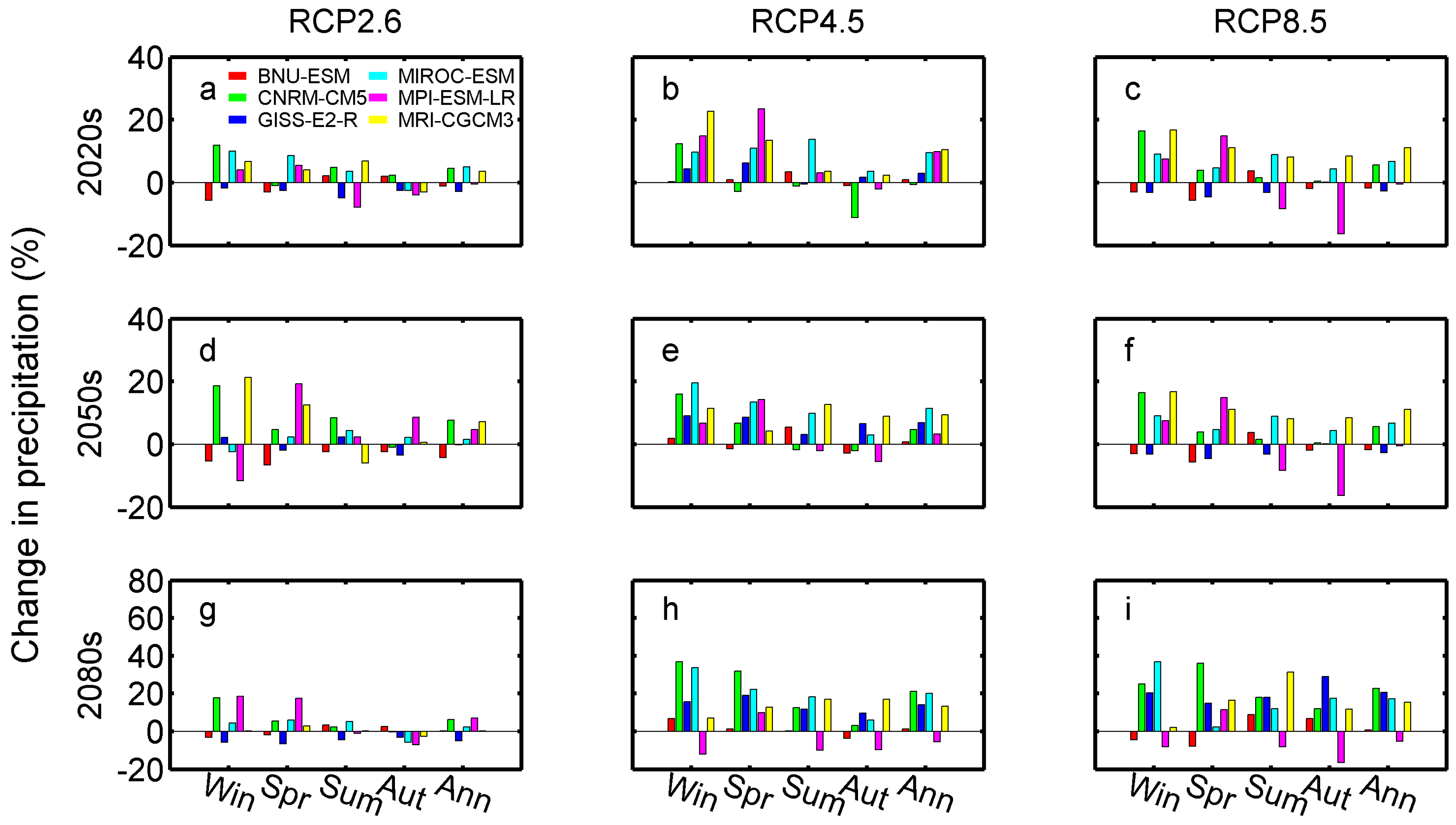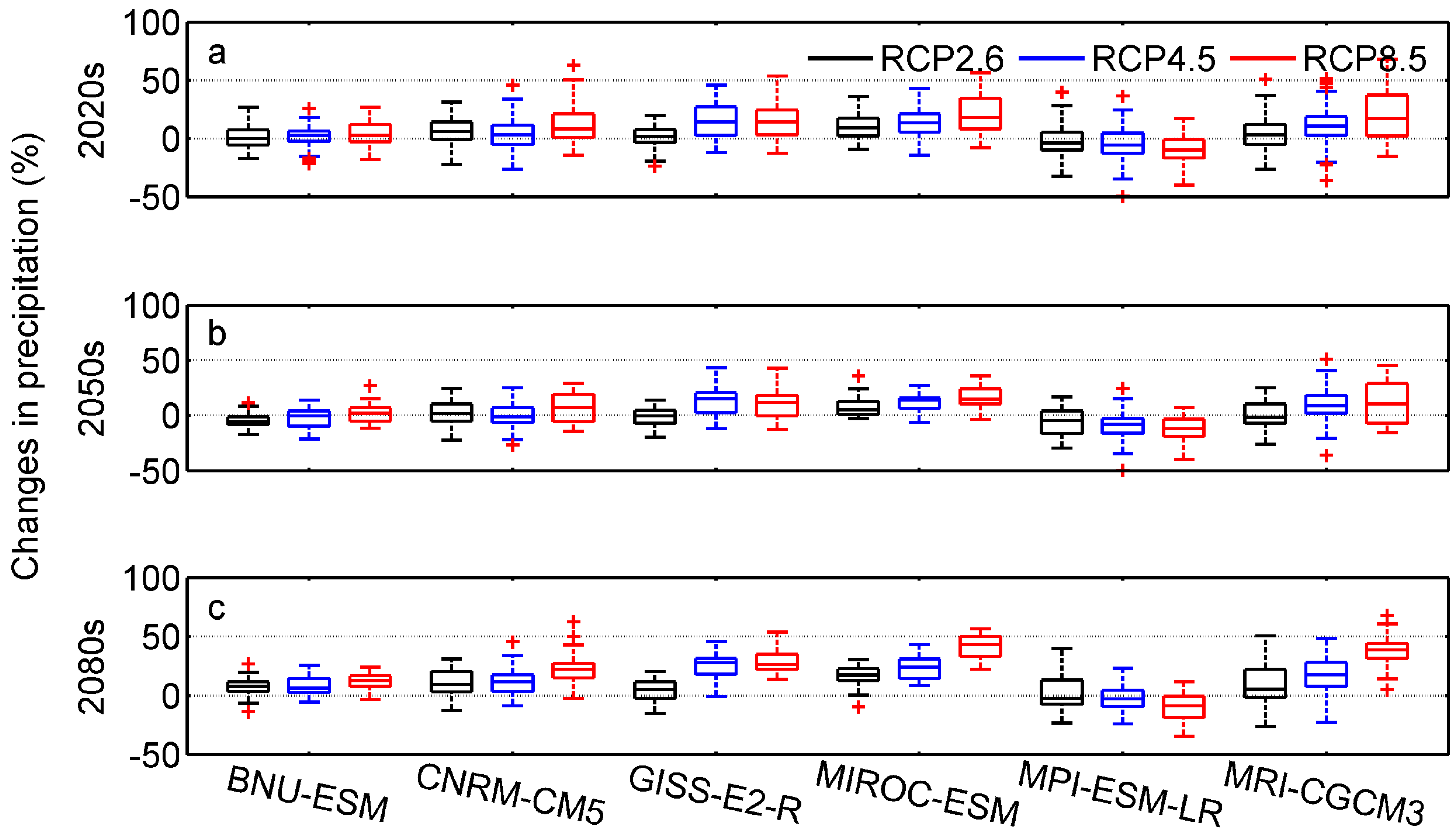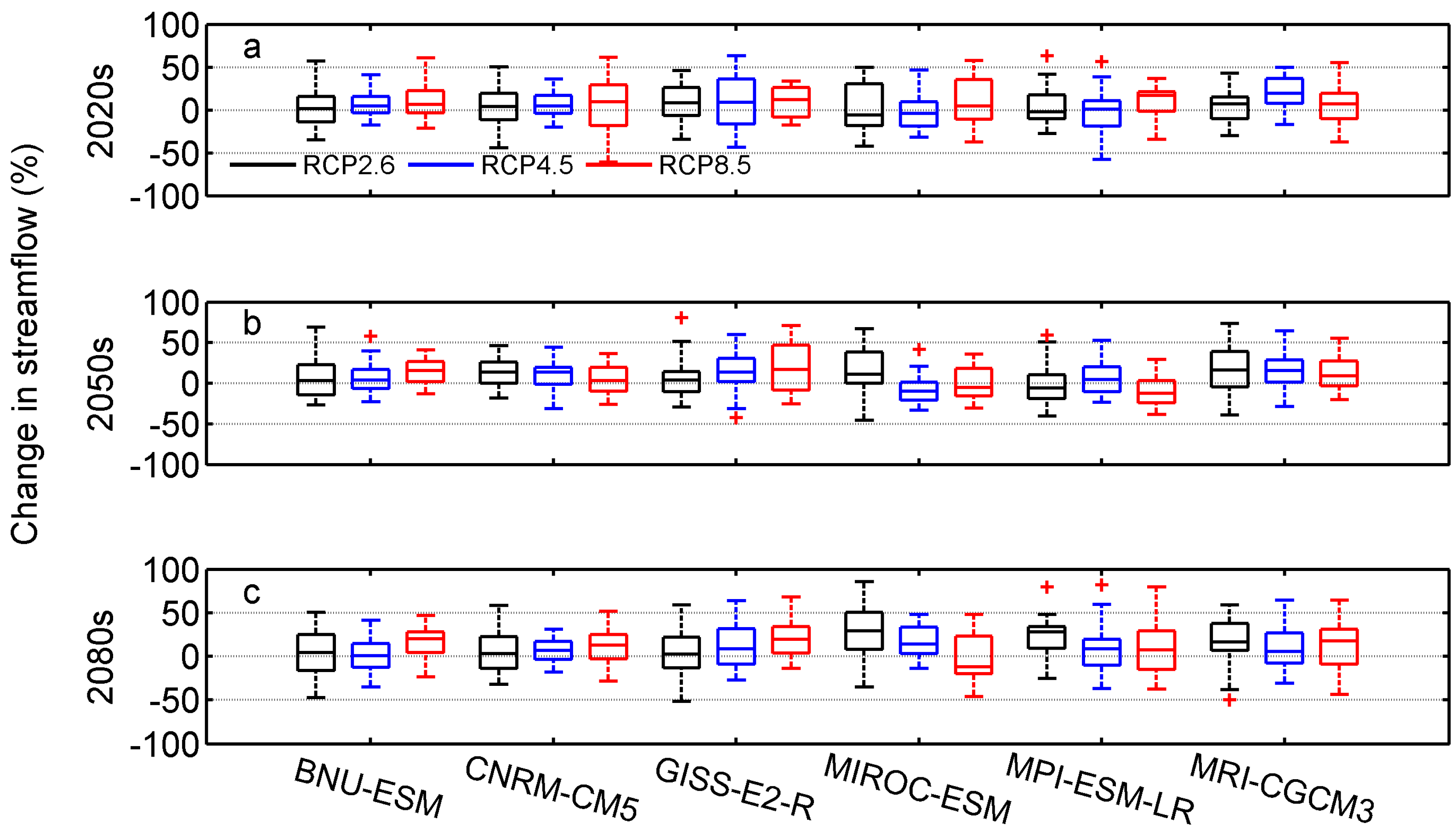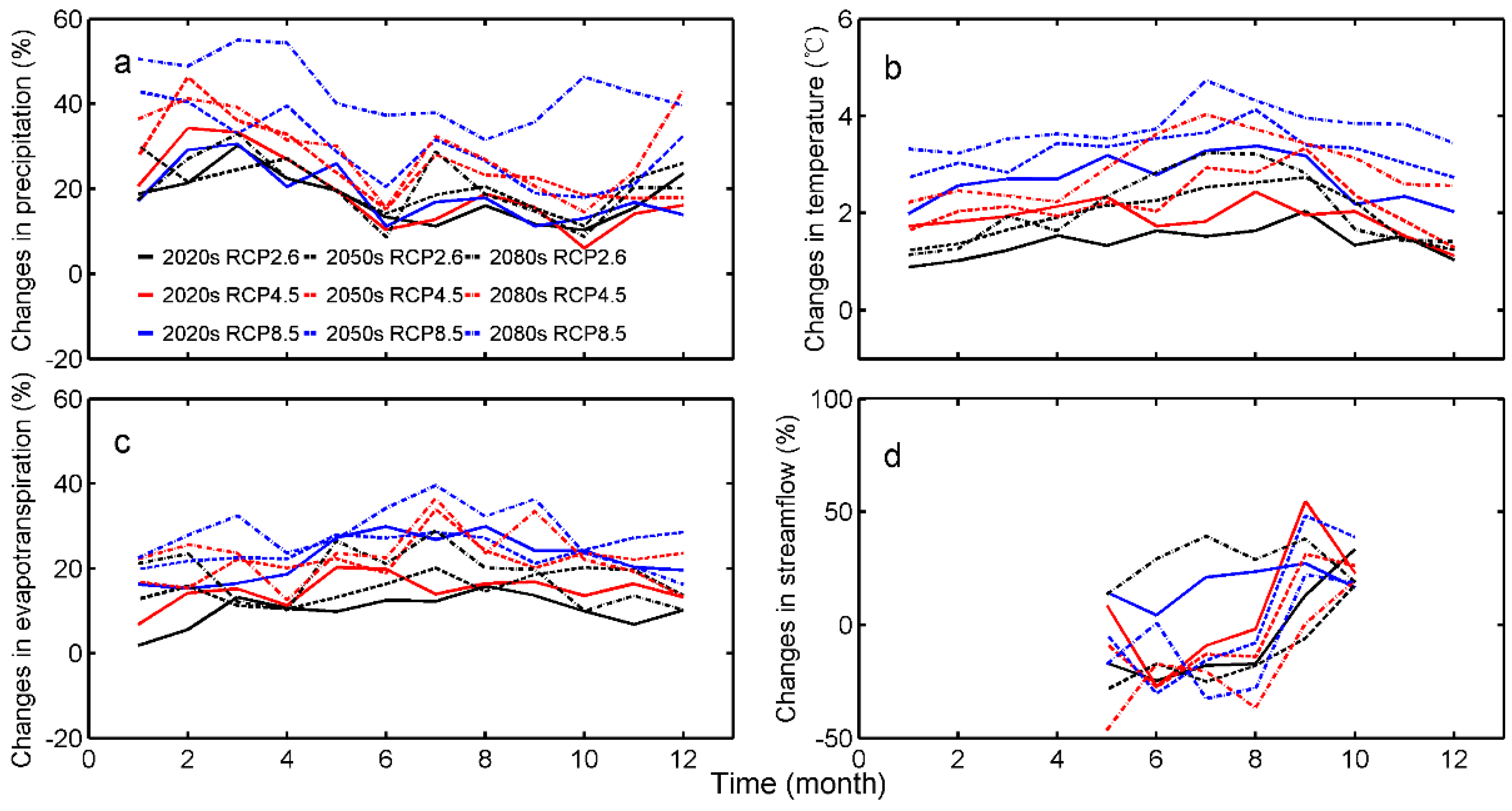The evaluation of the ability of the GCMs to correctly represent the past plays an important role in this study. Three criteria, including monthly mean value, correlation coefficient (R) and root mean square error (RMSE), were applied to accomplish this work. The results of the three criteria were respectively shown in
Figure 4 and
Table 4. For the monthly mean value of precipitation and temperature, the simulations of six GCMs showed acceptable results. For monthly temperature, the BNU-ESM projected the largest decrease (−3.29 °C) in February compares with the observed data while the MIROC-ESM gave the biggest increase (2.78 °C) in September. However, results were still acceptable while the changes of annual mean temperature of the six GCMs ranged from −0.32 °C to 1.07 °C. For the monthly mean precipitation, the change ratios ranged from −39.9% to 39.7%, however the annual mean value changed from −8.5% to 12.2% (June to October). For the R and RMSE, the six GCMs all showed satisfactory results. The R of precipitation ranged from 0.66 to 0.82 while that of temperature ranged from 0.82 to 0.93. The RMSE of precipitation ranged from 1.37 to 3.65 while that of temperature ranged from 0.08 to 1.52. In a word, based on the results of the three criteria, the six GCMs could correctly represent the past climate of this basin.
3.2.1. Changes in Seasonal Mean Precipitation and Temperature
As the basin hydrology appeared to be closely related to the seasonal climatic conditions, climate change scenarios and the data analysis were performed on a seasonal basis for the future.
Figure 5 and
Figure 6 show changes in seasonal mean precipitation and temperature for the future periods under different RCPs, respectively. For the seasonal precipitation predictions, most of the GCMs gave increase projections for all the three future periods under different RCP scenarios. As shown in the figure, RCP8.5 always predicted a greater increase than the RCP4.5 and RCP2.6 scenarios in the annual mean precipitation. For the multi-GCMs, the average changes in the annual precipitation were 5.4%, 6.3% and 6.1% under RCP2.6, 8.3%, 12.6% and 15.9% under RCP4.5, and 7.1%, 16.1% and 28.4% under RCP8.5 for 2020s, 2050s and 2080s, respectively. These statistical results showed that in the future, the precipitation is predicted to be increased during the twenty-first century, especially in the 2080s. However, it also showed that there exists a big difference between GCMs and RCPs, which means that GCMs and RCPs can be considered the most important contributor of the uncertainty in these analyses.
From
Figure 6, it was shown that the changes in temperature were not consistent with those of precipitation. The changes in temperature showed continuous growth. The average changes in annual mean temperature were 0.78 °C, 0.99 °C and 1.73 °C under RCP 2.6, 1.12 °C, 1.66 °C and 2.81 °C under RCP 4.5, 1.92 °C, 2.94 °C and 3.6 °C under RCP 8.5 for the 2020s, 2050s and 2080s, respectively.
For seasonal precipitation and temperature projected by different GCMs and RCPs, however, the difference in the seasonal values showed to be more significant than the annual changes. In general, this study area would be warmer and wetter in the future years.
3.2.2. Changes in Annual Mean Precipitation and Temperature
Table 6 and
Table 7 respectively show the annual changes in the maximum and minimum temperature values (denoted as Tasmax and Tasmin, respectively) for the future prediction periods using six different GCMs under the three RCPs scenarios. In comparison to the precipitation, the trend change in temperature data showed to be more consistent. However, for the annual mean Tasmax and Tasmin under different RCPs, MIROC-ESM simulation scenarios always provided the largest increase in the future predictions.
For the Tasmin condition, the multi-GCMs ensemble, for the three time periods studied, provided increase in the magnitude from 0.77 °C to 1.08 °C under RCP2.6, 1.85 °C to 2.59 °C under RCP4.5, and 1.08 °C to 5.32 °C under RCP8.5 scenarios. For Tasmax, however, the results were relatively different compared with the Tasmin; under RCP2.6, the increase ranged from 0.75 °C to 1.11 °C, 1.18 °C to 2.42 °C under RCP4.5, and 1.11 °C to 4.75 °C under RCP8.5. Thus, temperature appeared to be an important factor affecting mostly on the evapotranspiration and the streamflow, suggesting that understanding the future change in trends for the Tasmax and the Tasmin values are critically important in evaluating the effects of the climate change on streamflow.
Figure 7 presents the change ratios for the simulated annual mean precipitation, compared to the control period through box plot, which could be applied to illustrate the dispersal of the data, by combination of GCMs and RCPs for the future prediction periods respectively.
For the 2020s, 2050s and 2080s, MPI-ESM-LR always provided the largest decreases in the median values. During all the three periods examined, nearly all GCMs used showed consistent results; the change ratios (in median) of precipitation under RCP8.5 gave the biggest value, while those of the RCP2.6 scenarios gave the lowest values. The only exception, however, was the MPI-ESM-LR; the change ratio in 2080s presented the largest decrease under RCP8.5. For the 2050s, the three models (BNU-ESM, CNRM-CM5, and GISS-E2-R) showed similar trends, compared with the 2080s, while the other GCMs (MIROC-ESM, MPI-ESM-LR, and MRI-CGCM3) projected slight changes among each others. In the 2020s analyses, MRI-CGCM3 and MPI-ESM-LR showed the biggest increase of 8.6% and 6.9% under RCP8.5 and RCP4.5, respectively, whereas in the 2050s predictions, the GISS-E2-R under RCP2.6 showed the biggest increase (17.8%) while the MPI-ESM-LR under RCP8.5 presented the biggest decrease (−8.0%). Meanwhile, in the 2080s, MIROC-ESM under RCP8.5 projected the largest increase (40.1%) and MPI-ESM-LR under RCP8.5 predicted the largest decrease (−13.8%). Data in
Figure 8 also showed that the combinations of different GCMs and RCPs scenarios would lead to relatively a large amount of uncertainties in projecting the future climate change scenarios, and the uncertainty induced by GCM modeling itself is appeared to be the larger source, compared with the other sources of uncertainties.
3.2.3. Climate Change Impacts on Hydrology Simulations
Figure 8 gives the simulation results on annual mean evapotranspiration simulated by the DHSVM under different GCMs and RCPs in the future time periods with box plot method. From the figure, it was shown that the changes of evapotranspiration had some similarities. During all the GCMs, the medians of MPI-ESM-LR under RCP 8.5 always gave the largest decrease ranging from −4.07% to −1.93% in the three future periods. In 2020s, MRI-CGCM3 represented the biggest increase in median (4.06%) under RCP 8.5. In 2050s, GISS-E2-R gave the largest increase in median (8.06%) under RCP 8.5, while MIROC-ESM showed the biggest increase (18.8%) under RCP 8.5. In 2020s, half GCMs (GISS-E2-R, MIROC-ESM and MRI-CGCM3) showed increase trend under the three RCPs. In 2050s, four GCMs (CNRM-CM5, GISS-E2-R, MIROC-ESM and MRI-CGCM3) gave the increase trend. While in 2080s all the GCMs, except MPI-ESM-LR, gave the increase trend in median. From the figure, it was also showed that the RCP 8.5 always gave the largest increase in median, while the RCP 2.6 always gave the smallest.
Figure 9 gives the probability density functions (PDFs) of the annual mean temperature, precipitation, and seasonal mean streamflow projected by the six GCMs used under the three RCPs scenarios for the future long-term prediction (2011–2100). Overall, the PDFs showed that nearly all six GCMs and the RCPs scenarios projected increase in both temperature and precipitation, suggesting that the future climate in this study area projected by GCMs under three RCPs will most likely expected to be warmer and wetter. It also showed that the increase in the magnitude of the change varied greatly between the different combinations of the GCMs and the three RCPs scenarios. More precisely, for the annual mean temperature, under RCP2.6, the MPI-ESM-LR predicted the largest increase (0.66 °C), whereas, GISS-E2-R predicted a decrease, the only decrease situation (−0.34 °C) among all the GCMs and RCPs examined, while under RCP4.5, MIROC-ESM provided the largest increase (4.78 °C) and BNU-ESM provided the smallest increase (1.39 °C), and under RCP8.5, the MIROC-ESM projected the largest increase (6.68 °C) and CNRM-CM5 projected the lowest increase (2.11 °C). For the annual precipitation, however, the GCMs behaved relatively consistent with temperature data. However, BNU-ESM always provided the smallest increase, ranged from 1.18% to 14.32% under all the three RCPs scenarios, while CNRM-CM5, MRI-CGCM3, and MIROC-ESM, provided the largest increase of nearly 36%, 72% and 65% under RCP2.6, RCP4.5, and RCP8.5 scenarios, respectively. For the seasonal mean streamflow, all GCMs under RCPs scenarios showed increased trend for the future predictions, however the mean streamflow showed greater differences, compared with other scenarios. Furthermore, the MRI-CGCM3 showed the largest increase in trend, ranged from 14.2% to 22.9% for the mean values of the seasonal streamflow data, while the MPI-ESM-LR analyses suggested the smallest increase in the trend, ranged from nearly 7.0% to 13.7%. Overall, for GISS-E2-R, MIROC-ESM-LR, and MRI-CGCM3, the change in the mean streamflow values under RCP8.5 were smaller than those under RCP2.6 and RCP4.5 scenarios.
Figure 10 presents the box plots of change ratios of the streamflow during the melt season (May–October) under the three RCPs scenarios in the three future prediction periods. As was shown in the figure, the change ratios for the future streamflow and precipitation showed slightly difference. For the 2020s, MRI-CGCM3 showed the largest increase (19.54%) under RCP4.5 scenario in the median case, whereas, MIROC-ESM showed the largest decrease (−5.7%) under RCP2.6 scenario. For the 2050s periods, GISS-E2-R and MPI-ESM-LR under RCP8.5 scenario projected the largest increase (16.74%) and decrease (−12.47%), respectively. For the 2080s period, MIROC-ESM provided the largest increase (28.98%) under RCP2.6 and MIROC-ESM gave the largest decrease (−12.23%) under RCP8.5. The mean values of the median projected by all GCMs and RCPs scenarios were 5.76%, 6.31%, and 10.64% for the three future periods, respectively. While the mean values of streamflow projected by all GCMs used and the RCPs scenarios were 6.6%, 8.19% and 11.76% for three future periods, respectively. These analyses clearly showed that the larger increase in the streamflow trend was in the 2080s, compared to the 2020s and the 2050s periods, which suggest that in the future prediction periods. Some researches pointed out that the annual rainfall and streamflow in the Upper Yangtze River basin (UYRB) is projected to decrease over the next 90 years [
48,
49], however there were some differences with this study in precipitation and streamflow. The main reason might be the increase of the evapotranspiration and the snowmelt in the source region of the Yangtze River.
Figure 11 gives the changes ratios of monthly mean precipitation (a), temperature (b), evapotranspiration (c) and seasonal mean streamflow (d) for the future predictions under three RCPs. In this study, the multi-GCMs ensemble method was used to simulate the climate change scenarios which calculate the arithmetic mean value of the six GCMs outputs. In this study, the multi-GCM simulation was divided into nine scenarios (3 RCPs × 3 future periods).
For precipitation, however, the monthly changes showed interchangeable in the three future periods for the different scenarios. In all the scenarios tested, the trend of precipitation values in 2080s under RCP8.5 provided always the largest increase (31.52%–55.01%), while this trend in the precipitation in the 2020s showed the smallest increase. Furthermore, for all time period tested, multi-GCMs ensemble projected an increase in precipitation values, especially during the months of March, May and July. However in the Tuotuo River basin, summers have normally become much wetter as the precipitation distributions mostly concentrated during the months of May through August. The multi-GCMs ensemble results showed considerable differences between RCPs scenarios. The ensemble results also showed that the increase in the precipitation trend occurred mainly during the June and July time periods.
For temperature, the monthly results showed continuous change trends and all the predictions gave increase trends. During all the scenarios, the predictions in 2020s under RCP 2.6 always gave the smallest increase of variation (0.88 °C–2.03 °C), while those in 2080s under RCP 8.5 always gave the biggest increase (3.23 °C–4.73 °C). For all the months around the year, the biggest increase in temperature mainly occurred in July, August and September. In July, the increase in temperature ranged from 1.52 °C to 4.73 °C, in August, the increase ranged from 1.63 °C to 4.32 °C, while in September the increase ranged from 1.96 °C to 3.96 °C.
For evapotranspiration, it was shown in the figure that all the climate changes scenarios presented increase trends. During all the scenarios, the changes in 2080s under RCP 8.5 always showed the largest increase (16.25%–39.6%) while the changes in 2020s under RCP 2.6 always gave the smallest (1.86%–15.8%). It was also shown in the figure that the biggest increase mainly occurred in July (12.3%–39.6%), August (15.8%–32.25%) and September (13.6%–36.3%), which were similar to the changes of temperature.
Since the streamflow data were available only for the melting seasons (May to October) in Tuotuo River basin, the statistical comparison results of streamflow were also presented only for that specific time period. As indicted in
Figure 11a, precipitation performed a substantial increase in winter season (December–February) more than other seasons, meaning that there would be more snow accumulation in winter. However, as energy in the arid zone is sufficient for forcing evapotranspiration [
34], thus the increased precipitation would be mostly dissipated by increasing evapotranspiration and contribute to relatively little change of streamflow during this period in this study area.
Although the change in the monthly streamflow showed to be similar with the change in the monthly precipitation trend, there were negligible differences between them. Our analyses showed that among the future scenarios examined, the streamflow in 2020s under RCP2.6 and 2080s under RCP8.5 provided the smallest (4.36%) and biggest (41.52%) increases in trend, respectively, while the precipitation in 2080s under RCP8.5 always gave the biggest increase all year around. The main reason could most likely be due to the increase in temperature and the solar radiation during those time periods. This is primarily because the trend of temperature increase under RCP8.5 was more rapid than the same increase under RCP4.5 scenarios, suggesting that the increase in temperature corresponds to the increase in evapotranspiration that ultimately results in the decrease in streamflow. Thus, temperature can be considered as one of the key factors for analyzing the impacts of climate warming on the future prediction of the streamflow hydrology.
